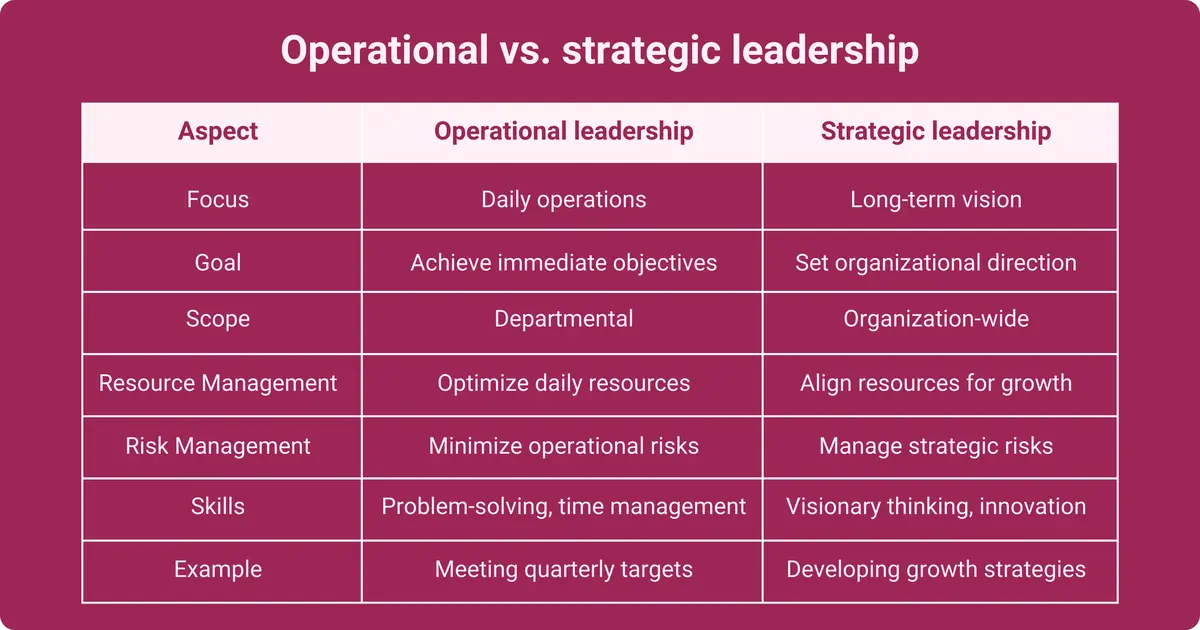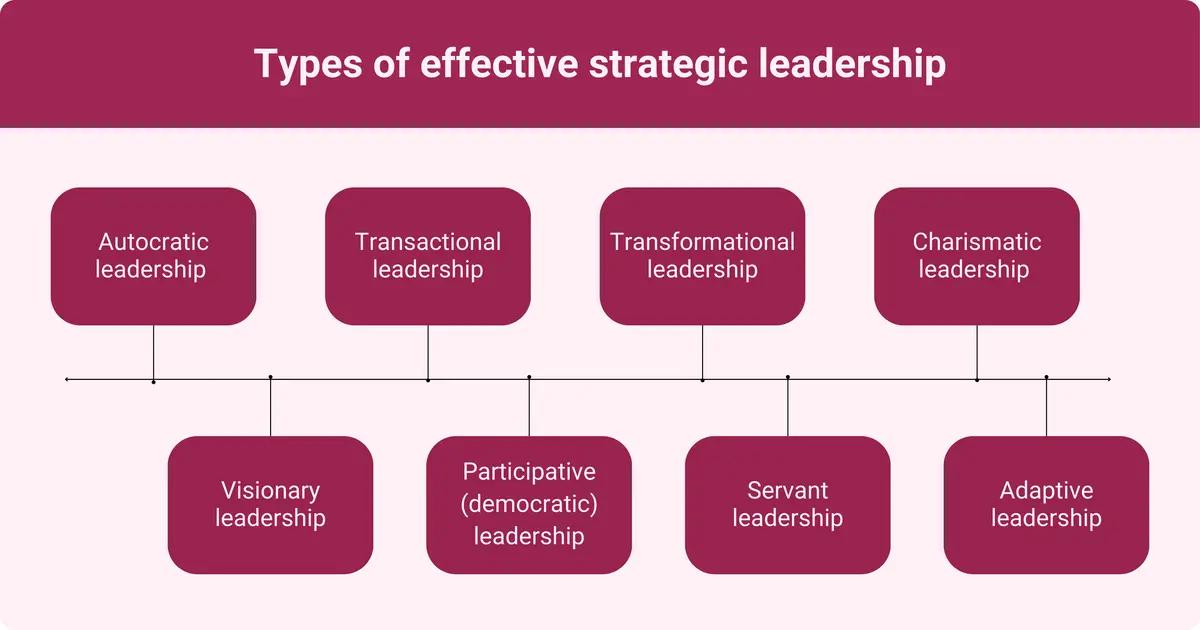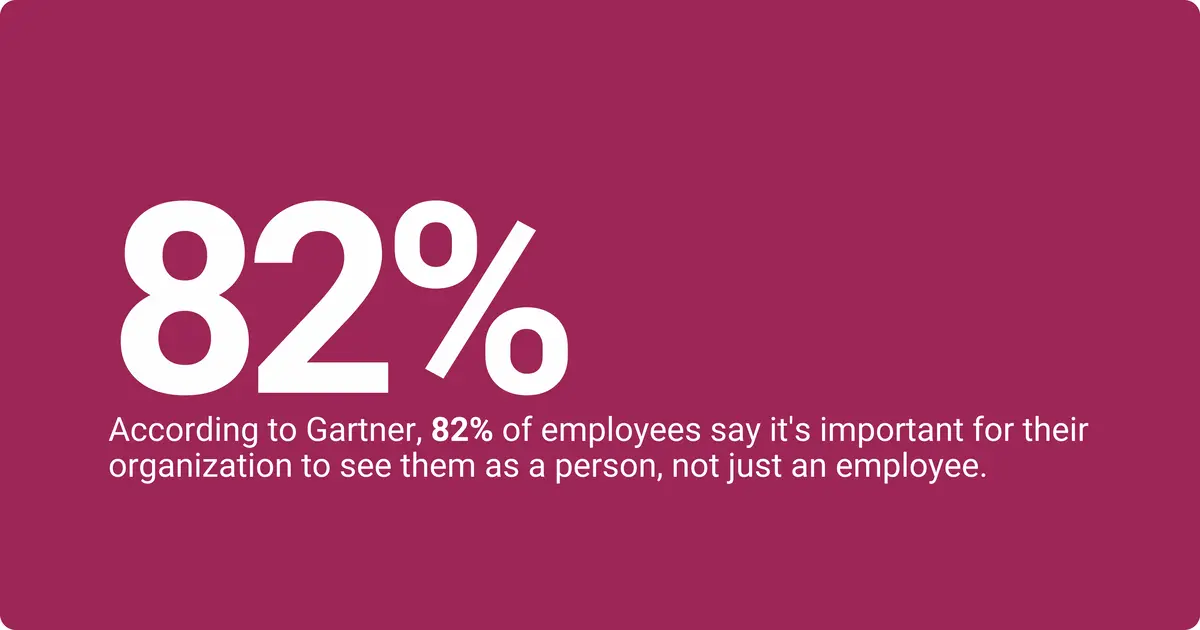What is Strategic Leadership? Exploring the Theories, Impact, and Examples
Table of contents
- What is strategic leadership?
- Why is strategic leadership important?
- What is the difference between operational leadership and strategic leadership?
- What are the principles of strategic leadership?
- 8 Types of effective strategic leadership
- What are the key characteristics and competencies of strategic leaders?
- How do you become a strategic leader?
- Examples of strategic leaders
- Start thinking strategically

The world's most impactful figures come from different places and backgrounds, but they have one thing in common: strategic leadership. However, a strategic mindset is far from the norm. A study by Management Review regarding leadership awareness of organizational strategiesOpens in a new tab revealed that only 28% of executives and middle managers could list three of their company's strategic priorities.
Leading strategically involves putting your organization's goals and vision front and center, but many current and prospective leaders may be unclear on what that entails. Here's everything potential strategic leaders need to know.
What is strategic leadership?
Strategic leadership is an approach to management that focuses on long-term objectives. A strategic leader guides an organization toward sustainable success through strategic thinking, establishing a clear vision and mission, and making thoughtful decisions that align with them.
This kind of leader also excels at adaptability, problem-solving, and navigating complex problems. They help their organization remain competitive even during a challenging societal, financial, and technological climate.
Why is strategic leadership important?
Strategic leadership is critical to driving business success and sustaining your competitive advantage. A study published in Management Science Letters found that it has a direct, positive effect on organizational performance. That correlation is rooted in improved employee engagement and morale, higher productivity, and greater innovation.
In addition, it enables leaders to streamline an organization's processes to achieve greater efficiency, helping to keep costs down and minimize risk. This kind of leadership is also central to your organization's ability to maneuver through complex and ever-changing environments.
What is the difference between operational leadership and strategic leadership?
Operational and strategic leadership both have a part to play in organizational effectiveness, but they're distinct concepts. Understand the differences between them to assemble a well-balanced organizational leadership team.
Operational leaders
Operational leaders focus on the here and now, monitoring performance, day-to-day efficiency, and task execution. Their goal-setting is generally limited to the near future, and they usually focus on a particular area of the business. Operational leaders have to make sure that employees follow processes and procedures in their daily tasks. They also have to solve unexpected problems as they arise.
Strategic leaders
Strategic leadership is broader in scope, future-focused, and change-oriented. A strategic leader defines the mission of the entire organization rather than a certain department and sets their sights on long-term goals. They develop and refine the processes that operational leaders oversee while also evaluating risks and employing strategic planning and performance management to protect the organization's interests.
Comparing leadership roles in action
To get a clearer picture of what sets operational and strategic leaders apart, consider what their jobs typically involve. For example, a strategic leader sets a budget and secures a loan for a new initiative meant to expand the company's reach. The operational leader oversees the allocation of those funds, confirming that they cover labor and materials required for the job.

What are the principles of strategic leadership?
Four foundational principles guide effective strategic leadership. When you use them correctly, they create a strong foundation for decision-making and organizational accomplishments.
1. Ploy
While the word "ploy" may make you think of deception, the ploy principle refers to a leader who knows how to craft tactics to seize opportunities and overcome obstacles. These maneuvers are often disruptive and surprising, particularly for other businesses in your market, to keep you one step ahead.
For example, if a competitor recently released a new product that's gaining popularity, a strategic leader might acquire the patent to create a similar product that appeals to their customer base.
Or you could expand your operations in a particular location before your competitor has the opportunity to move in, allowing you to get the edge early in the area. These are moves your competitors don't expect, so they won't have immediate plans to react to and recover from them.
2. Pattern
The second principle is a strategic leader's ability to recognize and leverage patterns and trends in the organization's past behavior, team outcomes, and competitors' actions.
The goal is to identify harmful or unproductive patterns that have become ingrained in your operations and strategies and remove them before they cause more damage. At the same time, you can target positive patterns or trends that you want to integrate into your organization's approach and strategic processes.
3. Position
Strategic leaders are integral to defining and solidifying an organization's market position and creating a competitive advantage. They consider points such as:
- How the company presents itself in the market and in customers' minds
- The brand's values and how to best represent them
- The nature and quality of products and services
With this information, you can find a niche for your business and attract customers with specific interests. You can also hone your brand image and organizational strategy.
4. Perspective
The final principle of strategic leadership is perspective, which encompasses the mindset, values, and worldview of the organization and the people who work there.
To shape a unified and forward-thinking perspective that inspires others, leaders must look at how employees perceive management, how customers see the company, and how investors view the organization.
You should also develop an awareness of the organization's culture and how it influences decision-making.
8 Types of effective strategic leadership
Depending on their personality, the organization's needs and challenges, and external circumstances, a leader can use a wide range of leadership styles. Each type offers unique advantages, and many of the most effective leaders blend elements from different types to achieve the best results.
Autocratic leadership
An autocratic or authoritarian leader bases their approach on individual control. They put little stock in input from group members, instead preferring to impose policies and set expectations based on their own knowledge and instincts. This kind of leader takes full control of the team and often keeps a close eye on employee performance.
Transactional leadership
A transactional leader prefers to use a system of give and take to motivate employees. They offer rewards and impose penalties to ensure employees meet their standards and expectations. In transactional leadership, the primary concern is maintaining organizational stability by closely monitoring whether the team completes tasks correctly and manages their time properly.
Transformational leadership
Transformational leaders inspire and motivate their teams to go beyond their perceived capabilities and embrace an innovative environment. They encourage employees to grow and promote personal and professional development while also aligning their goals with the organization's vision and mission.
To be truly transformational, a leader has to have a deep-rooted belief in this vision and embody it every day in the workplace.
Charismatic leadership
A charismatic leader makes use of their most valuable assets: their inherent charm and powerful communication. With these characteristics, they can naturally inspire and influence employees, customers, and stakeholders. They also develop emotional connections with employees, energizing and motivating them to do their best and live up to the expectations of a leader they admire.
Visionary leadership
Always looking toward the future, visionary leaders seize opportunities to innovate. They inspire others with their enthusiasm and clear vision of what the organization can accomplish. Most visionary leaders set ambitious objectives and motivate their teams so they can achieve them.
Rather than controlling their employees, they offer freedom to explore different paths toward a shared vision.
Participative (democratic) leadership
Participative leadership is the opposite of autocratic leadership. Rather than keeping all the decision-making power to themselves, a participative leader welcomes others into those discussions. They take a collective approach to problem-solving, recognizing that employees have special skills, knowledge, and experiences that can strengthen the organization.
Servant leadership
Servant leaders put the development and support of their employees first. They step back from their personal agendas and instead ensure the team and organization are flourishing. Servant leadership supports a more collaborative work environment that balances the needs of employees with business success.
Adaptive leadership
Adaptive leaders keep their organizations agile and ready for anything. They challenge widely accepted ideas, encourage continuous learning and growth, and promote resilience. Although they have set principles and tactics to draw from, they also remain flexible so they can adjust their strategies when needed.

What are the key characteristics and competencies of strategic leaders?
There's no blueprint for a strategic leader's personality, but there are critical characteristics that are nearly universal. With these essential skills, you can help your organization face challenges and achieve its goals.
1. Visionary thinking and strategic orientation
One of the most critical attributes of a strategic leader is the ability to anticipate what's coming next. You have to understand the relationship between your organization and its environment to develop plans that support your organization's goals.
A wise leader also enhances their vision by asking experts from inside and outside the organization to offer insights and recommendations.
2. Effective communication
As a strategic leader, you should be able to articulate your organization's vision, goals, and plans. You'll also need to clearly explain your ideas and take in feedback and concerns from others. Active listening and open communication are important to all stakeholders.
3. Adaptability and change management
Flexibility is at the heart of virtually every strong strategic leader. To maintain your company's performance, you have to manage adjustments, find and capitalize on opportunities, and minimize risks to the organization. As circumstances and industry dynamics change, you'll need to shift your ideas and approach.
4. Integrity and ethical judgment
A strategic leader needs strong integrity and ethics to build a positive organizational environment. A survey by LRN on the correlation between corporate culture and business performanceOpens in a new tab found that companies with the strongest ethical cultures outperformed others by 40% in areas such as employee loyalty, growth, and customer satisfaction. Showing your integrity and being honest is key to building trust with employees and customers.
5. Innovative mindset and creativity
Most strategic leaders are good at thinking outside of the box. They have inventive ideas and find novel solutions to drive improvements. A strategic leader who embodies and promotes innovation also inspires a similar mindset in employees.
6. Emotional intelligence and empathy
According to Gartner, 82% of employees say it's important for their organization to see them as a person, not just an employee. Displaying emotional intelligence and empathy, even when providing feedback, helps you connect with employees and highlights how you value them.
A people-focused leader who manages their emotions and empathizes with others positions you to resolve conflicts, manage your teams, and handle interpersonal relationships.

7. Decisiveness and problem-solving
Strategic leaders shouldn't be prone to rash decisions and should have the confidence and competence to draw informed, timely conclusions.
Your decisiveness underscores your deep understanding of the organization. This, in turn, helps you build a more positive, future-oriented environment.
8. Accountability and responsibility
An organization with a culture of ownership is primed for growth and improvement, but that accountability has to begin at the top. As a mindful leader, you should be ready and willing to take responsibility for your actions and their outcomes. This shows that everyone, from entry-level employees to chief executives, can make decisions and answer for their mistakes.
9. Collaborative approach and influence
Another vital characteristic of a strategic leader is the ability to build partnerships and work effectively with others. Collaboration allows you to influence your team and learn from their diverse perspectives. You can then collectively work together to achieve your common goals.
10. Continuous learning and development
The most effective strategic leaders are always open to learning new things. They're passionate about leadership development, exploring new ideas, participating in professional events, pursuing further education, and reaching out to mentors. This commitment to personal and professional growth helps you stay informed about industry trends and demonstrates the value of learning to your employees.
How do you become a strategic leader?
Strategic leaders aren't born overnight. They develop over years defined by effort, experimentation, and education. However, these tips will help move you toward strategic leadership:
- Cultivate a strategic mindset: Start by practicing critical thinking, questioning the status quo, and centering your thoughts and plans around long-term goals.
- Foster adaptability: Encourage adaptability within yourself and your organization by seeking differing viewpoints, promoting creativity, and identifying potential obstacles.
- Invest in continuous learning: Dedicate time and resources to education through workshops, books, and classes focused on leadership skills and areas of expertise in your industry.
- Build trust: As much as possible, be transparent and authentic with employees by showing who you really are and proving you're open to learning more about their personalities and strengths.
- Align organizational goals: Set clear objectives and keep employees on the right track by breaking down larger, company-wide goals into smaller ones that each team or department can tackle.
- Embrace innovative thinking: Rather than boxing yourself in with methods from the past, try challenging assumptions, taking calculated risks, and testing new ideas to find the best solutions to problems – and encourage your employees to do the same.
While these steps offer a good beginning, remember that the pace of your progress will also depend on your experience, ambition, and dedication.
Examples of strategic leaders
The past and present have a lot to say about what strategic leadership looks like. Examining the styles of some of the most influential individuals in history shows just how far this type of leadership can take you.
Historical figures
Strategic leaders have been shaping politics, business, and society for centuries. Take these revolutionary figures:
- Winston Churchill: As prime minister of the United Kingdom during World War II, Churchill inspired a nation to work toward a common goal: ending the war and restoring peace.
- Abraham Lincoln: Another transformational leader who stepped into power at a time of crisis, Lincoln appealed to people's morals and encouraged them to look beyond themselves to the good of the nation.
- Martin Luther King Jr.: As a charismatic servant leader, Martin Luther King Jr. used his oratory skills and personality to connect with people and inspire them to fight for civil rights.
- Henry Ford: Ford was a visionary and autocratic leader who envisioned how to improve car production with the assembly line and maintained very strict control over employee processes.
While people often associate each of these people with a distinct kind of leadership, keep in mind that they used elements of different styles. For instance, Churchill was a transformational leader who also used charisma to connect to the masses.
Modern leaders
Although they may not be in the history textbooks yet, today's strategic leaders are also changing the way we live and look at the world:
- Jeff Bezos: Bezos is a transformational leader who realized his vision of transitioning Amazon from an online bookstore to an e-commerce giant.
- Sheryl Sandberg: As the former Chief Operating Officer (COO) of Facebook, Sandberg combined empathy, resilience, and inclusivity with mentorship and empowerment to redefine the company's workplace culture.
- Howard Schultz: Schultz, the former Chief Executive Officer (CEO) of Starbucks, was a servant leader who made waves when he instituted a policy providing employees with comprehensive health coverage even if they worked part-time.
- Oprah Winfrey: Former talk-show host and all-around media maven, Winfrey is a transformational and charismatic leader who inspires her team with her vision and her audience with her ability to listen.
These are only a few of the strategic leaders dominating the financial and corporate worlds, and they set the bar high. Don't feel pressured to instantly become a Bezos or Ford. Instead, take gradual steps to become the ideal strategic leader for your organization.
Start thinking strategically
With so many styles and methods to choose from, you'll ultimately have to discover your personal leadership strategy.
Communication, collaboration, empathy, and visionary thinking are a good place to start, but your approach to strategic leadership could change with the world around you. For instance, in a world dominated by social media, charismatic leadership, in particular, has never been more important.
However, don't be afraid to forge your own path as a strategic leader. Your willingness to test different tactics will lead to lasting personal and organizational success.